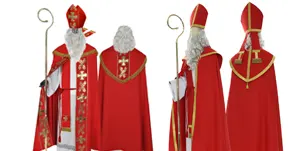Sets of Liturgical Vestments
Liturgical vestments are grand and beautiful pieces, garments that are soaked in historical meaning and symbolism. Vestments are the clothes that are worn by members of the clergy during Mass and other services and duties. From the deacons to the bishops and everyone in between, there is a vestment for each level of service to the church - and sometimes even for specific celebrations and feast days. Here we will take a more detailed look at them and their roles in the church.
You can find sets of liturgical vestments available to order at vestment.co.uk.
What are Liturgical Vestments
Liturgical vestments have more purpose than just the clothes that are worn by members of the clergy. The majority of them have a long and rich history, being adopted into the church for hundreds - if not thousands of years! Therefore they each have a deep significance and purpose, for example, the chasuble represents the garment that was worn by Jesus during his passion and symbolizes the deep connection between the priest and Christ during Mass. Alongside this they signify charity, a core value of the church.
Deeper Meanings and Symbolism
Liturgical vestments are often adorned with a plethora of patterns and liturgical motifs, some of these giving further meaning to the pieces. For example, a funeral pall is often embellished with a large cross, spanning the entire length and breadth of the cloth, signifying Christ's triumph over sin and death as he was crucified. Marian vestments - or vestments that are worn to celebrate significant feast days of the Virgin Mary - can be embellished with images of the Virgin Mary herself or symbols that represent her, and garments for everyday use are likely to display the crucifix.
The liturgical calendar often calls for a myriad of clothing for members of the clergy, and alongside the deep and spiritual meaning of the garments themselves, and the symbolism behind the motifs and decorations of the garbs, often the item's colour plays an important role. Sets of liturgical vestments often signify a message to the congregation and convey a specific meaning to the parish, and this is most often accomplished with colour and matched to the liturgical calendar.
Sets of Liturgical Vestments
Sets of liturgical vestments are used across the church to display a unified image, often during Mass there can be multiple members of the clergy at the altar, helping out the priest with his service or overseeing the smaller tasks. Vestment sets ensure that all members are dressed cohesively and are presenting the appropriate colours.
Multiple vestments will often come in matching pairs or even entire sets - specific vestments are more appropriate to match than others. For example, oftentimes priests and deacons will be stood shoulder to shoulder in the church and are frequently seen together, therefore it is important the priest’s chasuble and the deacon’s dalmatic are matching. Other vestments are often worn together at the same time, such as the chasuble and cope, or the cope and mitre to name a few. Again it is wise to ensure that these pieces are matching in order to properly showcase the garments and their holy meanings.
To Conclude
Vestments and members of the clergy go hand in hand within the church, often being donned at times of worship or celebration. Whilst being a lot more than simply beautiful pieces, liturgical vestments symbolize the changing of the liturgical seasons and also signify a clergyman's position within the church. Sets of vestments will be found in the wardrobes of any churches as they are seen as key parts to the services and duties taken up by their wearers.










